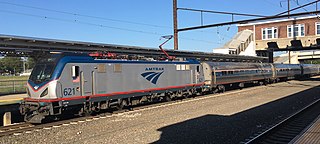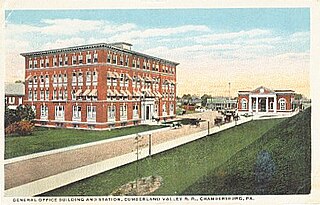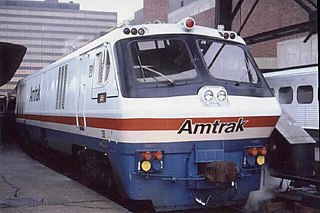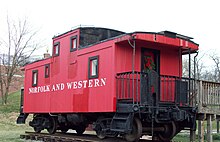
The Metroliners were extra-fare high-speed trains between Washington, D.C., and New York City which operated from 1969 to 2006. They were briefly first operated by Penn Central Transportation, then by Amtrak for 35 years.

The Keystone Service is a 195 mile regional passenger train service from Amtrak, that operates between the Harrisburg Transportation Center in Harrisburg, Pennsylvania, and 30th Street Station in Philadelphia, running along the Philadelphia to Harrisburg Main Line. Most trains then continue along the Northeast Corridor (NEC) to Penn Station in New York City.

MARC is a commuter rail system in the Washington–Baltimore area. MARC is administered by the Maryland Transit Administration (MTA) and operated under contract by Alstom and Amtrak on track owned by CSX Transportation (CSXT) and Amtrak. In 2023, the system had a ridership of 3,860,600, or about 10,800 per weekday as of the first quarter of 2024, less than pre-COVID-19 pandemic weekday ridership of 40,000.

Baltimore Penn Station, formally named Baltimore Pennsylvania Station in full, is the main inter-city passenger rail hub in Baltimore, Maryland. Designed by New York City architect Kenneth MacKenzie Murchison (1872–1938), it was constructed in 1911 in the Beaux-Arts style of architecture for the Pennsylvania Railroad. It is located at 1515 N. Charles Street, about a mile and a half north of downtown and the Inner Harbor, between the Mount Vernon neighborhood to the south, and Station North to the north. Originally called Union Station because it served the Pennsylvania Railroad and Western Maryland Railway, it was renamed to match other Pennsylvania Stations in 1928.

The Northeast Corridor Line is a commuter rail service operated by NJ Transit between the Trenton Transit Center and New York Penn Station on Amtrak's Northeast Corridor in the United States. The service is the successor to Pennsylvania Railroad commuter trains between Trenton and New York, and is NJ Transit's busiest commuter rail service. After arrival at New York Penn Station, some trains load passengers and return to New Jersey, while others continue east to Sunnyside Yard for storage. Most servicing is done at the Morrisville Yard, at the west end of the line.
The Junction Railroad was a railroad created in 1860 to connect lines west of downtown Philadelphia, Pennsylvania, and allow north-south traffic through the metropolitan area for the first time. The railroad consisted of 3.56 miles of double track and 5.3 miles of sidings. It owned no locomotives or rolling stock. The line connected the Philadelphia and Reading Rail Road line at the west end of the Columbia Bridge over the Schuylkill River, crossed the Pennsylvania Railroad line, ran parallel to Market Street, and turned south to connect with the Philadelphia, Wilmington and Baltimore Railroad at Gray's Ferry.

Suburban Station is an art deco office building and underground commuter rail station in Penn Center in Philadelphia. Its official SEPTA address is 16th Street and JFK Boulevard. The station is owned and operated by SEPTA and is one of the three core Center City stations on the SEPTA Regional Rail and one of the busiest stations in the Regional Rail System.

The Baltimore and Potomac Railroad (B&P) operated from Baltimore, Maryland, southwest to Washington, D.C., from 1872 to 1902. Owned and operated by the Pennsylvania Railroad, it was the second railroad company to connect the nation's capital to the Northeastern U.S., and competed with the older Baltimore and Ohio Railroad.

The Philadelphia, Wilmington and Baltimore Railroad (PW&B) was an American railroad that operated independently from 1836 to 1881. Headquartered in Philadelphia, it was greatly enlarged in 1838 by the merger of four state-chartered railroads in three Mid-Atlantic states to create a single line between Philadelphia and Baltimore.

West Baltimore station is a commuter rail station located in the western part Baltimore, Maryland, along the Northeast Corridor. It is served by MARC Penn Line trains. The station is positioned on an elevated grade at 400 Smallwood Street near parallel West Mulberry and West Franklin Streets extending off U.S. Route 40. Three large surface lots are available for commuters. The station only has staircases from street level and two low-level side platforms next to the outer tracks and is thus not accessible to people with some mobility disabilities, but MTA Maryland plans to renovate the station with accessible platforms and entrances.

The Pope's Creek Subdivision is a CSX Transportation railroad line in Maryland, running from Bowie the Morgantown Generating Station in Morgantown, Maryland. The Herbert Subdivision to the Chalk Point Generating Station connects to it at Brandywine and the Indian Head-White Plains railroad used to connect to it at White Plains. Its name comes from Pope's Creek in Newburg, MD to where it originally ran.

The Cumberland Valley Railroad was an early railroad in Pennsylvania, United States, originally chartered in 1831 to connect with Pennsylvania's Main Line of Public Works. Freight and passenger service in the Cumberland Valley in south central Pennsylvania from near Harrisburg to Chambersburg began in 1837, with service later extended to Hagerstown, Maryland, and then extending into the Shenandoah Valley to Winchester, Virginia. It employed up to 1,800 workers.

52nd Street is a closed train station that was located at the intersection of North 52nd Street & Merion Avenue in the West Philadelphia section of Philadelphia, Pennsylvania, United States. It was built by the Pennsylvania Railroad (PRR) at the junction of its Main Line and its Schuylkill Branch. Today, these lines are the SEPTA Regional Rail Paoli/Thorndale Line and Cynwyd Line, respectively.

Bowie State station is a regional rail station on the Northeast Corridor, located adjacent to the campus of Bowie State University in Bowie, Maryland. It is served by MARC Penn Line commuter rail trains. The station is located on a three-track section of the Northeast Corridor, with two side platforms next to the outer tracks.

The Beacon Hill was a daily 157-mile (253 km) commuter rail service operated by Amtrak between Boston, Massachusetts, and New Haven, Connecticut, from 1978 to 1981. The Beacon Hill was one of the last long-haul commuter services operated by Amtrak. Service consisted of a single rush-hour round trip, with service eastbound to Boston in the morning and westbound to New Haven in the evening.

The Wilmington Rail Viaduct is a series of fills and bridges, about 4 miles (6.4 km) long, that carries the Northeast Corridor through the city of Wilmington, Delaware, above street level. Constructed between 1902 and 1908, the structure consists principally of fills supported by heavy stone retaining walls, punctuated with plate girder bridges over streets, and augmented by a few sections of brick arch viaduct. Its construction is typical of the Pennsylvania Railroad's architectural practices at the time, and the viaduct has been documented by the Historic American Engineering Record and listed on the National Register of Historic Places. Built by the Pennsylvania Railroad (PRR) as part of a series of grade crossing eliminations along the Northeast Corridor, the elevation of the rail line necessitated several other changes to rail infrastructure in Wilmington, including the construction of the Wilmington Shops at the east end of the viaduct, and the construction of the Wilmington Station and adjacent Pennsylvania Railroad Office Building along the elevated right-of-way.

The Budd Metroliner was a class of American electric multiple unit (EMU) railcar designed for first-class, high-speed service between New York City and Washington, D.C., on the Northeast Corridor. They were designed for operation up to 150 miles per hour (240 km/h): what would have been the first high speed rail service in the Western Hemisphere. Although 164 mph (264 km/h) was reached during test runs, track conditions and electrical issues limited top speeds to 120 mph (190 km/h) in revenue service. The single-ended units were designed to be arranged in two-car sets, which were in turn coupled into four to eight-car trains.

The Chesapeake was a daily passenger train operated by Amtrak along the Northeast Corridor between Washington, D.C., and Philadelphia, Pennsylvania, from 1978 to 1983. It was one of the few commuter trains operated by Amtrak.
The Clamdigger was a daily passenger train which ran along the Northeast Corridor during the 1970s. The train had two iterations: from 1898 to 1972 it was a local commuter service under the New Haven Railroad, Penn Central, and Amtrak between New London and New Haven, while from 1976 to 1978 it was a long-distance commuter service operated by Amtrak from Providence to New Haven. In 1978, it was canceled and replaced with the Beacon Hill.
Lanham station was a regional rail station on the Northeast Corridor, located just outside the Capital Beltway off Route 450 in Lanham, Maryland. It was served by the predecessor of today's MARC Penn Line, until August 1982.
























